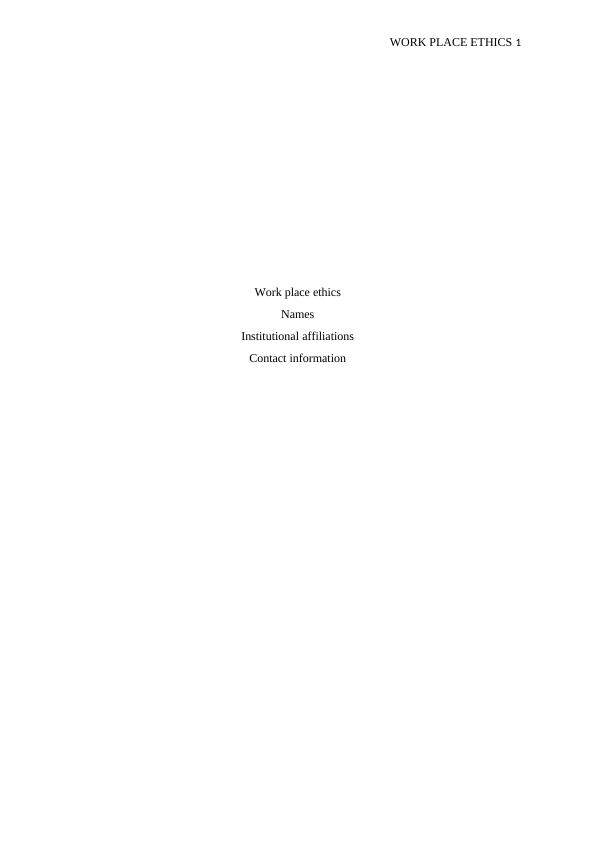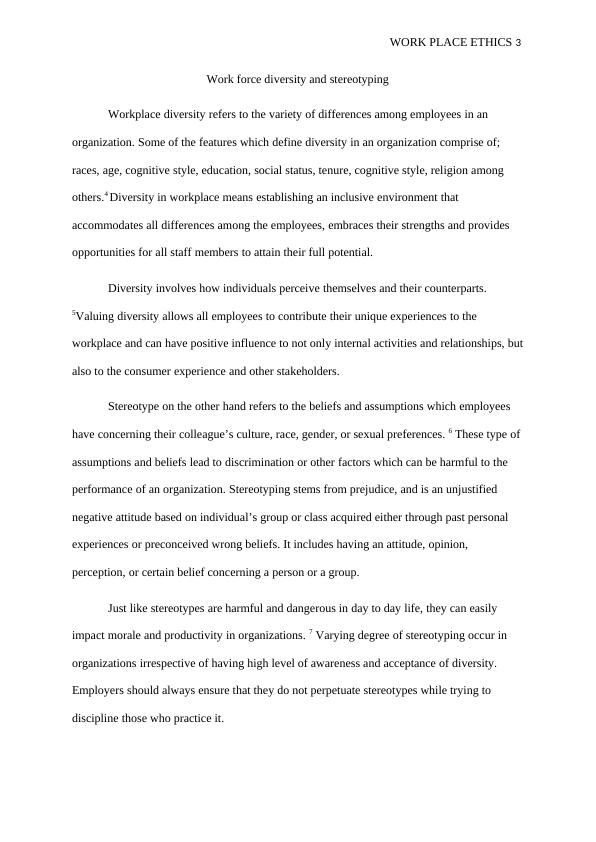Work Place Ethics
Added on 2020-03-16
10 Pages2015 Words77 Views
WORK PLACE ETHICS 1Work place ethicsNamesInstitutional affiliationsContact information

WORK PLACE ETHICS 2IntroductionWhile the traditional notion of workplace diversity may refer to representations of various races, gender and religious backgrounds, today’s concept of workplace diversity is all-encompassing. 1 Apart from these variables, considerations are also made on age, personality, education, skillset, cognitive styles, and background among others. Companies that are focused to establishing a diverse work benefits from harnessing a pool of individuals with unique qualities. They view combination of differences in workplace as a potential growth rather than opportunities for conflict.As time goes on, workforce diversity is becoming an important tool due to various reasons. One of these reasons is that it makes employees to have various opinions and perspectives. When staff members of different backgrounds and experiences come together, they bring different perspectives, hence leading to effective solutions and approaches to different problems that may impact the success of an organization.Workplace diversity is also known to create innovations. 2 When performing duties with colleagues of different backgrounds, skills and working styles, creative ideas can be developed from bouncing concepts from each other. Creative innovations enables an organization to attain a competitive advantage because consumers always wants to be associated with firms that develop unique and high quality goods and services. The other importance of workplace diversity is that it enables organizations to grow apool of talents.3 when companies encourage diversity, they attract wide range of potential candidates to their vacancies because the applicants views them as more progressive and unbiased. When this happens, the management gets a chance to select an exceptional candidate.

WORK PLACE ETHICS 3Work force diversity and stereotypingWorkplace diversity refers to the variety of differences among employees in an organization. Some of the features which define diversity in an organization comprise of; races, age, cognitive style, education, social status, tenure, cognitive style, religion among others.4 Diversity in workplace means establishing an inclusive environment that accommodates all differences among the employees, embraces their strengths and provides opportunities for all staff members to attain their full potential. Diversity involves how individuals perceive themselves and their counterparts. 5Valuing diversity allows all employees to contribute their unique experiences to the workplace and can have positive influence to not only internal activities and relationships, butalso to the consumer experience and other stakeholders.Stereotype on the other hand refers to the beliefs and assumptions which employees have concerning their colleague’s culture, race, gender, or sexual preferences. 6 These type of assumptions and beliefs lead to discrimination or other factors which can be harmful to the performance of an organization. Stereotyping stems from prejudice, and is an unjustified negative attitude based on individual’s group or class acquired either through past personal experiences or preconceived wrong beliefs. It includes having an attitude, opinion, perception, or certain belief concerning a person or a group.Just like stereotypes are harmful and dangerous in day to day life, they can easily impact morale and productivity in organizations. 7 Varying degree of stereotyping occur in organizations irrespective of having high level of awareness and acceptance of diversity. Employers should always ensure that they do not perpetuate stereotypes while trying to discipline those who practice it.

End of preview
Want to access all the pages? Upload your documents or become a member.
Related Documents
Diversity in Businesslg...
|7
|1299
|409
(PDF) Diversity and diversity policylg...
|17
|4003
|79
Work and Diversity: Understanding Personal Cultural Competence and the Importance of Diversity in the Workplacelg...
|10
|2165
|127
Managing Diversity in an Organizationlg...
|8
|1733
|25
Equality and Diversity in the Workplace: A Study on TESCOlg...
|9
|2694
|37
Diversity in the Organization Documentlg...
|6
|1888
|20
